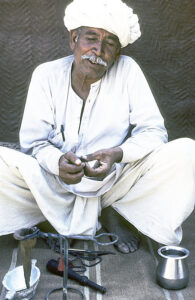Kaj Halberg - writer & photographer
Travels ‐ Landscapes ‐ Wildlife ‐ People
India 1991: Bishnoi people live in harmony with nature
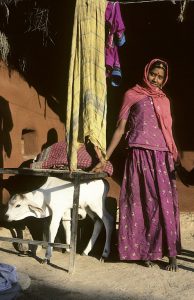
A group of slender and graceful women are already gathered here, wearing colourful local dresses, and adorned with rings of silver and gold around their arms and ankles, in the ear lobes, and on fingers and toes. They talk and laugh, their beautiful teeth glancing white. When they have filled their clay jars or shining brass jars with water, they return to their home.
Elsewhere at the waterhole, numerous splendid peacocks (Pavo cristatus) strut about, the males displaying their gorgeous tail to impress the females. These, however, show a complete lack of interest.
In a fallow field nearby, a herdsman is singing while seeing to it that his cattle don’t graze in the bright green fields of millet. At the same time, he keeps an eye on an approaching herd of blackbuck (Antilope cervicapra), to make sure that they won’t eat too many of the crops.
This species is described in depth on the page Travel episodes – India 1979: Hunting blackbuck with camera.


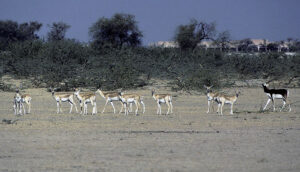
The khejari tree is sacred to the Bishnoi people, as its fruits are edible and highly nutritious. For this reason, 363 Bishnoi men, women, and children tried to prevent the felling of the trees by embracing them, but they were all killed by the Maharaja’s soldiers. When this action was related to the Maharaja, he was devastated, ordering his men to spare the Bishnoi’s khejari trees in the future. To commemorate the event, a temple was built in a small village, which today bears the name of Khejarli.
The word bishnoi is derived from the Hindi bis (twenty) and nau (nine). This religious movement was initiated by Ghambe-ji, who lived in the beginning of the 16th Century. He belonged to the second highest Hindu caste, kshatriya (warriors), but abandoned Hinduism to preach his own set of rules, 29 in all, the most important of which were non-violence and vegetarianism. Many people joined this new religion.
Initially, anybody could join the movement, but today you are born into the Bishnoi caste. The majority of Bishnois live in Rajasthan, in the vicinity of the city of Jodhpur.
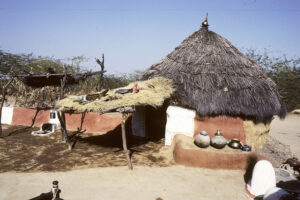
Thanks to this protection by the Bishnoi, a threatened species like the blackbuck has found a refuge in their area, where you may also encounter many slender Gujarat gazelles (Gazella bennettii ssp. christii), also known as chinkara, and the huge nilgai antelope (Boselaphus tragocamelus). In Hindi, nil means ‘blue’ and gai ‘bull’. Due to its similarity to the sacred cow, this animal is also protected by Hindus.
Trees are also protected by the Bishnoi, because they provide shade, and timber for house construction. The event with the embracement of the khejari trees at Jodhpur was a source of inspiration for a grassroot movement, Chipko Andolan (‘Embrace Movement’), which was founded in 1979 in the Kumaon Hills, Uttarakhand.
In this region, local politicians issued a permit for a timber company to fell all trees in an area, in which local villagers a month earlier had been denied a permit to cut wood for their daily need. Many of the village women were furious and, spontaneously, went into the forest to embrace the trees, thus preventing the lumber jacks from felling the trees. This action spread to nearby villages, and the timber company retreated from the area.

The walls of the buildings are mud, mixed with cow dung, which deters flies and other pests. Before this mixture dried, the women made fine patterns in the surface, using their fingers.
In the courtyard, several types of crops are spread out on mats to dry in the sun, including seed pods of three wild types of legumes, khejari, gowar, and khair acacia (Senegalia catechu), two types of lentils, millet, jowar (Sorghum bicolor), cucumber, and sesame.
An open-air kitchen is situated in a corner of the courtyard, where Bhiya Ram’s wife and a daughter-in-law are busy cooking. Soon we are served a delicious meal of lentils and other pulses, cooked with dahi (yoghurt), ghee (clarified butter), and chili fruits, which have been crushed on a flat, smooth stone with a stone roll. With the meal comes chapatis (pancake-shaped loaves), made from coarse millet flour.
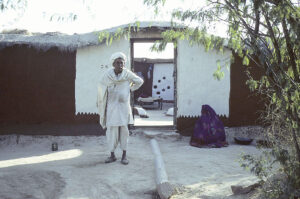
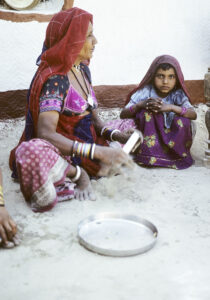
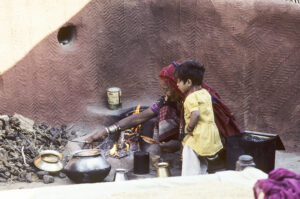
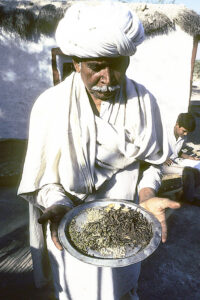
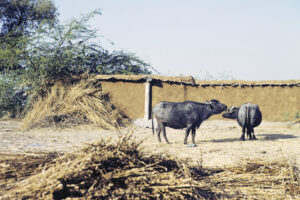
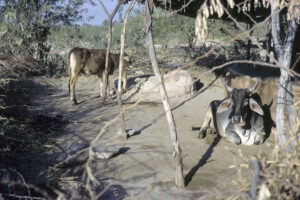
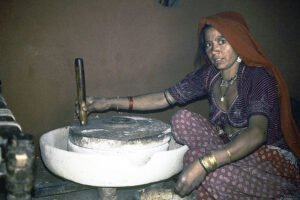
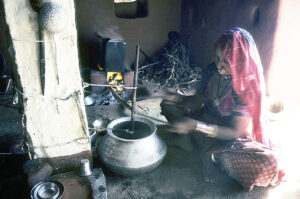
Nevertheless, a wedding can only take place after a year of plenty, when heavy rain has fallen, and crops are plentiful. The party lasts three days, during which the guests are served an abundance of food and tea, and entertainment is delivered by local musicians.
Marriages are arranged by the parents, who make the agreement without consulting the involved children. Often, they are married at a very young age, four or five years, but the girl will stay with her parents until she is 15 to 18 years old. She will then move to her husband’s home, and this event is celebrated with a more modest party.
The girl’s family will inform the husband’s family, when time is ripe for her to move. The previous night, the boy as well as the girl will relax with their families, while the women sing love songs for them. These songs have a soothing effect on the young people, describing pleasures and sorrows of a marriage, and thus bride and groom are prepared for their future life.
The women also see to it that the expectations of the couple are not too high, thus making it easier for them to tolerate the shortcomings of their spouse. Divorces are indeed very rare among the Bishnoi.
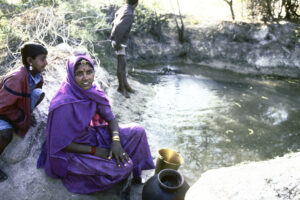
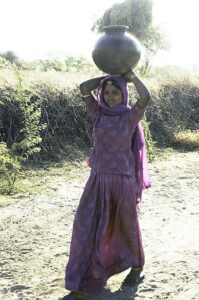
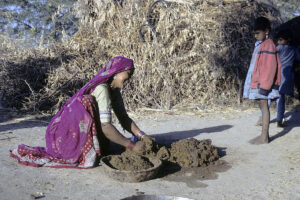
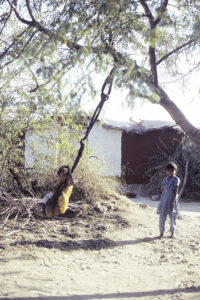
This ritual is a bond of friendship among the Bishnoi, who do not smoke or drink alcohol, opium being their only vice.
